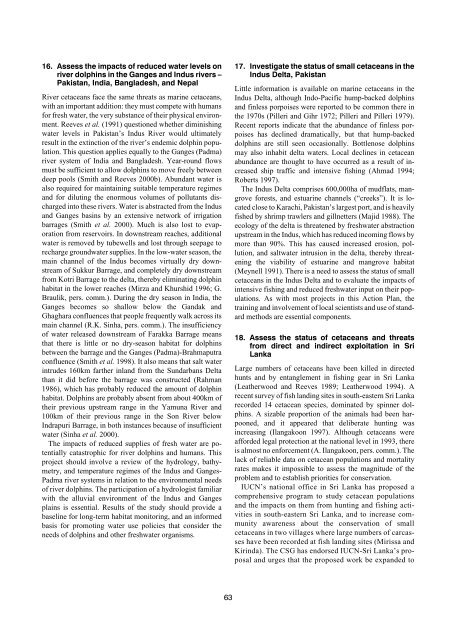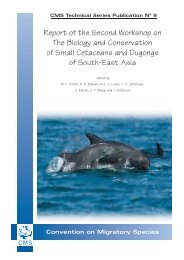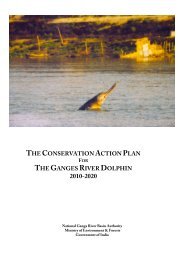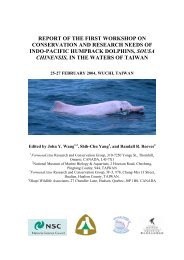Dolphins, Whales and Porpoises: 2002-2010 Conservation - IUCN
Dolphins, Whales and Porpoises: 2002-2010 Conservation - IUCN
Dolphins, Whales and Porpoises: 2002-2010 Conservation - IUCN
You also want an ePaper? Increase the reach of your titles
YUMPU automatically turns print PDFs into web optimized ePapers that Google loves.
16. Assess the impacts of reduced water levels on<br />
river dolphins in the Ganges <strong>and</strong> Indus rivers –<br />
Pakistan, India, Bangladesh, <strong>and</strong> Nepal<br />
River cetaceans face the same threats as marine cetaceans,<br />
with an important addition: they must compete with humans<br />
for fresh water, the very substance of their physical environment.<br />
Reeves et al. (1991) questioned whether diminishing<br />
water levels in Pakistan’s Indus River would ultimately<br />
result in the extinction of the river’s endemic dolphin population.<br />
This question applies equally to the Ganges (Padma)<br />
river system of India <strong>and</strong> Bangladesh. Year-round flows<br />
must be sufficient to allow dolphins to move freely between<br />
deep pools (Smith <strong>and</strong> Reeves 2000b). Abundant water is<br />
also required for maintaining suitable temperature regimes<br />
<strong>and</strong> for diluting the enormous volumes of pollutants discharged<br />
into these rivers. Water is abstracted from the Indus<br />
<strong>and</strong> Ganges basins by an extensive network of irrigation<br />
barrages (Smith et al. 2000). Much is also lost to evaporation<br />
from reservoirs. In downstream reaches, additional<br />
water is removed by tubewells <strong>and</strong> lost through seepage to<br />
recharge groundwater supplies. In the low-water season, the<br />
main channel of the Indus becomes virtually dry downstream<br />
of Sukkur Barrage, <strong>and</strong> completely dry downstream<br />
from Kotri Barrage to the delta, thereby eliminating dolphin<br />
habitat in the lower reaches (Mirza <strong>and</strong> Khurshid 1996; G.<br />
Braulik, pers. comm.). During the dry season in India, the<br />
Ganges becomes so shallow below the G<strong>and</strong>ak <strong>and</strong><br />
Ghaghara confluences that people frequently walk across its<br />
main channel (R.K. Sinha, pers. comm.). The insufficiency<br />
of water released downstream of Farakka Barrage means<br />
that there is little or no dry-season habitat for dolphins<br />
between the barrage <strong>and</strong> the Ganges (Padma)-Brahmaputra<br />
confluence (Smith et al. 1998). It also means that salt water<br />
intrudes 160km farther inl<strong>and</strong> from the Sundarbans Delta<br />
than it did before the barrage was constructed (Rahman<br />
1986), which has probably reduced the amount of dolphin<br />
habitat. <strong>Dolphins</strong> are probably absent from about 400km of<br />
their previous upstream range in the Yamuna River <strong>and</strong><br />
100km of their previous range in the Son River below<br />
Indrapuri Barrage, in both instances because of insufficient<br />
water (Sinha et al. 2000).<br />
The impacts of reduced supplies of fresh water are potentially<br />
catastrophic for river dolphins <strong>and</strong> humans. This<br />
project should involve a review of the hydrology, bathymetry,<br />
<strong>and</strong> temperature regimes of the Indus <strong>and</strong> Ganges-<br />
Padma river systems in relation to the environmental needs<br />
of river dolphins. The participation of a hydrologist familiar<br />
with the alluvial environment of the Indus <strong>and</strong> Ganges<br />
plains is essential. Results of the study should provide a<br />
baseline for long-term habitat monitoring, <strong>and</strong> an informed<br />
basis for promoting water use policies that consider the<br />
needs of dolphins <strong>and</strong> other freshwater organisms.<br />
17. Investigate the status of small cetaceans in the<br />
Indus Delta, Pakistan<br />
Little information is available on marine cetaceans in the<br />
Indus Delta, although Indo-Pacific hump-backed dolphins<br />
<strong>and</strong> finless porpoises were reported to be common there in<br />
the 1970s (Pilleri <strong>and</strong> Gihr 1972; Pilleri <strong>and</strong> Pilleri 1979).<br />
Recent reports indicate that the abundance of finless porpoises<br />
has declined dramatically, but that hump-backed<br />
dolphins are still seen occasionally. Bottlenose dolphins<br />
may also inhabit delta waters. Local declines in cetacean<br />
abundance are thought to have occurred as a result of increased<br />
ship traffic <strong>and</strong> intensive fishing (Ahmad 1994;<br />
Roberts 1997).<br />
The Indus Delta comprises 600,000ha of mudflats, mangrove<br />
forests, <strong>and</strong> estuarine channels (“creeks”). It is located<br />
close to Karachi, Pakistan’s largest port, <strong>and</strong> is heavily<br />
fished by shrimp trawlers <strong>and</strong> gillnetters (Majid 1988). The<br />
ecology of the delta is threatened by freshwater abstraction<br />
upstream in the Indus, which has reduced incoming flows by<br />
more than 90%. This has caused increased erosion, pollution,<br />
<strong>and</strong> saltwater intrusion in the delta, thereby threatening<br />
the viability of estuarine <strong>and</strong> mangrove habitat<br />
(Meynell 1991). There is a need to assess the status of small<br />
cetaceans in the Indus Delta <strong>and</strong> to evaluate the impacts of<br />
intensive fishing <strong>and</strong> reduced freshwater input on their populations.<br />
As with most projects in this Action Plan, the<br />
training <strong>and</strong> involvement of local scientists <strong>and</strong> use of st<strong>and</strong>ard<br />
methods are essential components.<br />
18. Assess the status of cetaceans <strong>and</strong> threats<br />
from direct <strong>and</strong> indirect exploitation in Sri<br />
Lanka<br />
Large numbers of cetaceans have been killed in directed<br />
hunts <strong>and</strong> by entanglement in fishing gear in Sri Lanka<br />
(Leatherwood <strong>and</strong> Reeves 1989; Leatherwood 1994). A<br />
recent survey of fish l<strong>and</strong>ing sites in south-eastern Sri Lanka<br />
recorded 14 cetacean species, dominated by spinner dolphins.<br />
A sizable proportion of the animals had been harpooned,<br />
<strong>and</strong> it appeared that deliberate hunting was<br />
increasing (Ilangakoon 1997). Although cetaceans were<br />
afforded legal protection at the national level in 1993, there<br />
is almost no enforcement (A. Ilangakoon, pers. comm.). The<br />
lack of reliable data on cetacean populations <strong>and</strong> mortality<br />
rates makes it impossible to assess the magnitude of the<br />
problem <strong>and</strong> to establish priorities for conservation.<br />
<strong>IUCN</strong>’s national office in Sri Lanka has proposed a<br />
comprehensive program to study cetacean populations<br />
<strong>and</strong> the impacts on them from hunting <strong>and</strong> fishing activities<br />
in south-eastern Sri Lanka, <strong>and</strong> to increase community<br />
awareness about the conservation of small<br />
cetaceans in two villages where large numbers of carcasses<br />
have been recorded at fish l<strong>and</strong>ing sites (Mirissa <strong>and</strong><br />
Kirinda). The CSG has endorsed <strong>IUCN</strong>-Sri Lanka’s proposal<br />
<strong>and</strong> urges that the proposed work be exp<strong>and</strong>ed to<br />
63





